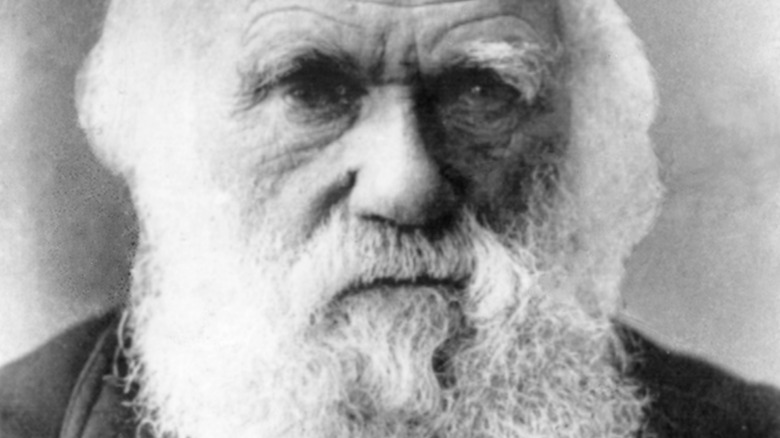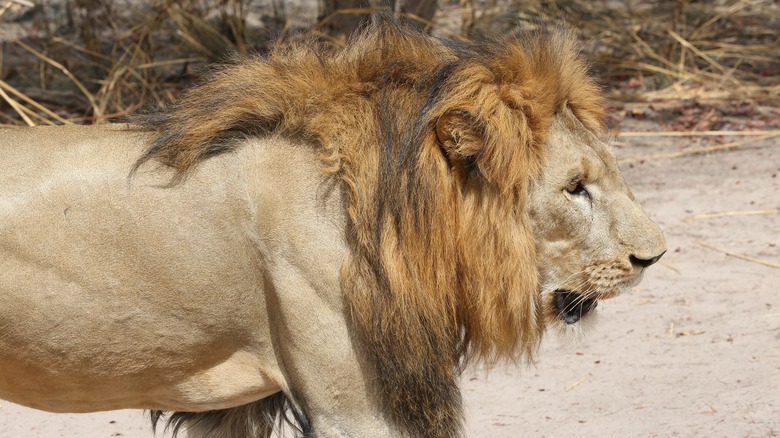Charles Darwin's Lion Theory You Don't Hear Much About
The lion is one of the most majestic and iconic creatures on Earth. African lions, per National Geographic, boast roars mighty enough that they're audible more than five miles away, and they're unique in that they aren't solitary animals, as is typical of big cats. Their famous prides, reportedly, can be home to up to 40 individuals. Big, happy, furry families.
Each species of big cat boasts its own unique traits, of course. The tiger, according to Britannica, truly puts the big into big cat: it's the largest cat species of all, with the Siberian tiger reaching a truly terrifying 13 feet (4 meters) in length. While tigers have their beautiful stripes, lions are known for their fabulous manes.
Said manes, National Geographic goes on, tend to be (but are not exclusively) boasted by male lions. It seems that Charles Darwin had a curious — and distinctly violent — theory as to why males boast this shock of hair around their faces.
The mystery of the mane
Lions' manes are some of the most striking adornments in the animal kingdom. It follows, then, that scientists will have pondered why the males of the species (predominantly) have them. They are, after all, unique; as the University of Minnesota's Craig Packer put it (via Big Cat Rescue), "Among carnivores, male lions are the only ones that carry an extravagant ornament."
Naturalist Charles Darwin eagerly weighed in on the mystery of the mane. Never afraid to share his opinion on all creatures great and small, he offered a curious theory on the subject that certainly seems to have a lot of credibility to it.
The fourth chapter of his famous work "The Origin of Species" (via The Literature Network) tackles the topic of natural selection. Within it, Darwin discusses the notion of sexual selection, which he described as "a struggle between the individuals of one sex, generally the males, for the possession of the other sex. The result is not death to the unsuccessful competitor, but few or no offspring." On the subject of carnivores, Darwin adds, "special means of defense may be given through means of sexual selection, as the mane of the lion ... for the shield may be as important for victory as the sword or spear."
The dark mane effect
What did Darwin mean by the "shield?" It was believed, per the University of Minnesota's College of Biological Sciences, that manes serve as a sort of hairy helmet, protecting battling lions from fierce blows to their vulnerable heads. This may well be a contributing factor, but fighting lions reportedly tend to target other regions of the body.
The concept of sexual selection is an intriguing one. Per Big Cat Rescue, the suggestion is that lions with large (or perhaps darker) manes could be seen as more desirable mates, because they indicate that the animal endured while drawing more attention to itself.
In 2006, Big Cat Rescue goes on, the University of Minnesota's Craig Packer and Peyton West conducted a study to see whether certain types of manes on males were more appealing to lionesses. Using model lions and false manes that ranged in color from blond to black, they determined that the lion with the darkest mane proved most popular, and this was echoed with real lions. "In 12 of 13 observations of males with multiple partners," according to West, "the darkest-maned male was the favored choice." Perhaps male lions have learned that their spectacularly be-maned heads aren't the best spots to strike in a fight. Perhaps female lions have concluded that males with darker manes are the best fathers for their cubs (Big Cat Rescue reports that they have more chance of living through an injury and have more testosterone). Darwin's words seem to reflect this.


